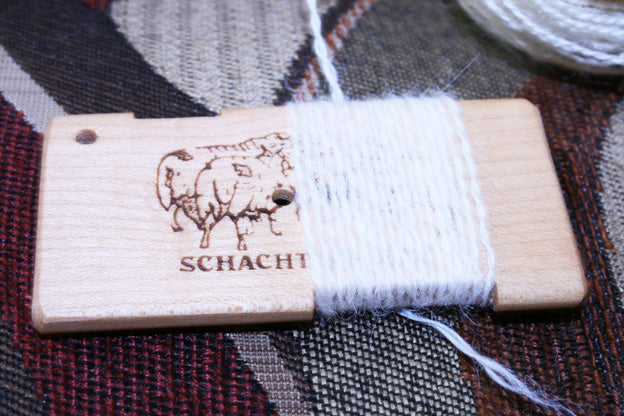It's easy to adapt weaving patterns so you can use up stash yarn—even mystery yarn! Our Weaving Toolbox has some useful tools to help you choose the right reed for your yarn, and recalculate the yardage needed.
We'll use Anne Sammons's Stash Buster Scarf as an example. The original design uses DK weight knitting yarn and an 8 dent reed. At 8 ends per inch (EPI), with 65 warp ends, the warp measured 8-1/8" in the reed. Anne used a nearly balanced plain weave, beating at 6 to 7 picks per inch (PPI).
Recalculating Sett
Say you wanted to use unlabeled yarn from your stash. First, figure out its wraps per inch (wpi) with a ruler or a yarn gauge. Wrap the yarn around the tool for 1 inch, with the wraps touching but not overlapping. Count the wraps—this yarn measures 19 wpi.

Next, try out our handy guide in the Weaving Toolbox, Choosing Rigid Heddle Reeds for Knitting Yarns. It uses standard yarn weight numbers and wraps per inch to recommend reed sizes. At 19 wpi, this yarn is a laceweight (size 0), and the guide suggests a 15 dent reed for a sett of 15 EPI (ends per inch). We'll throw caution to the winds and take this suggestion without sampling.
Grab your calculator. Multiply the design's width in reed by your new sett:
8.125 x 15 = 121.875
Round this number to 121 or 122, and that's your new total number of warp ends. For a rigid heddle project, you may prefer an odd number of warp ends so that both selvedge ends end up in slots (or holes).
If you want to make the scarf narrower or wider, you'd use the same calculation, multiplying your new width in reed by the desired sett.
width in reed x EPI = total number of warp ends
Recalculating Yardage
Once you know the total number of warp ends, you can figure out how much yarn you'll need. When you use the Warp and Weft Calculator in the Weaving Toolbox, you can adjust your project on the fly!
The Stashbuster Scarf calls for an 84" warp length (including take-up, shrinkage, and loom waste) to make a 54" scarf. However, when you substitute a finer yarn and need more warp ends, you'll need more yarn to weave a scarf of the same size. Use this online calculator to see how yardage requirements change—try a narrower scarf with fewer warp ends, or a shorter scarf. Don't forget to allow for take-up, shrinkage, and yarn waste as you play.
With mystery yarn, we often don't know how many yards we've got in a ball or partial skein. Jane Patrick explains how to use a Yarn Balance and a scale in Calculating Yardage.
These simple online tools and formulas make it easy for you to substitute yarns in weaving patterns. You'll find other resources online, like how to determine the fiber content of a mystery yarn.
A final tip: even with all these tools and calculations, you never know how yarns will behave until you sample. We always recommend weaving and wet-finishing a sample when you're working with unfamiliar yarns.
Resources
Choosing Rigid Heddle Reeds for Knitting Yarns
Beth Smith, Cheviot for Warp and Weft

